Step into the world of grace and artistry with our in-depth exploration of the diagram of a pointe shoe. This essential footwear, designed to elevate dancers to new heights, holds a captivating story of craftsmanship, customization, and aesthetics. Join us as we unveil the intricate details and fascinating history behind this iconic dance shoe.
From the materials used in its construction to the techniques employed in its shaping, every aspect of a pointe shoe is meticulously engineered to support and enhance the dancer’s performance. Discover the secrets behind the vamp, box, shank, and heel, and delve into the manufacturing process that brings these components together.
Design Elements of a Pointe Shoe
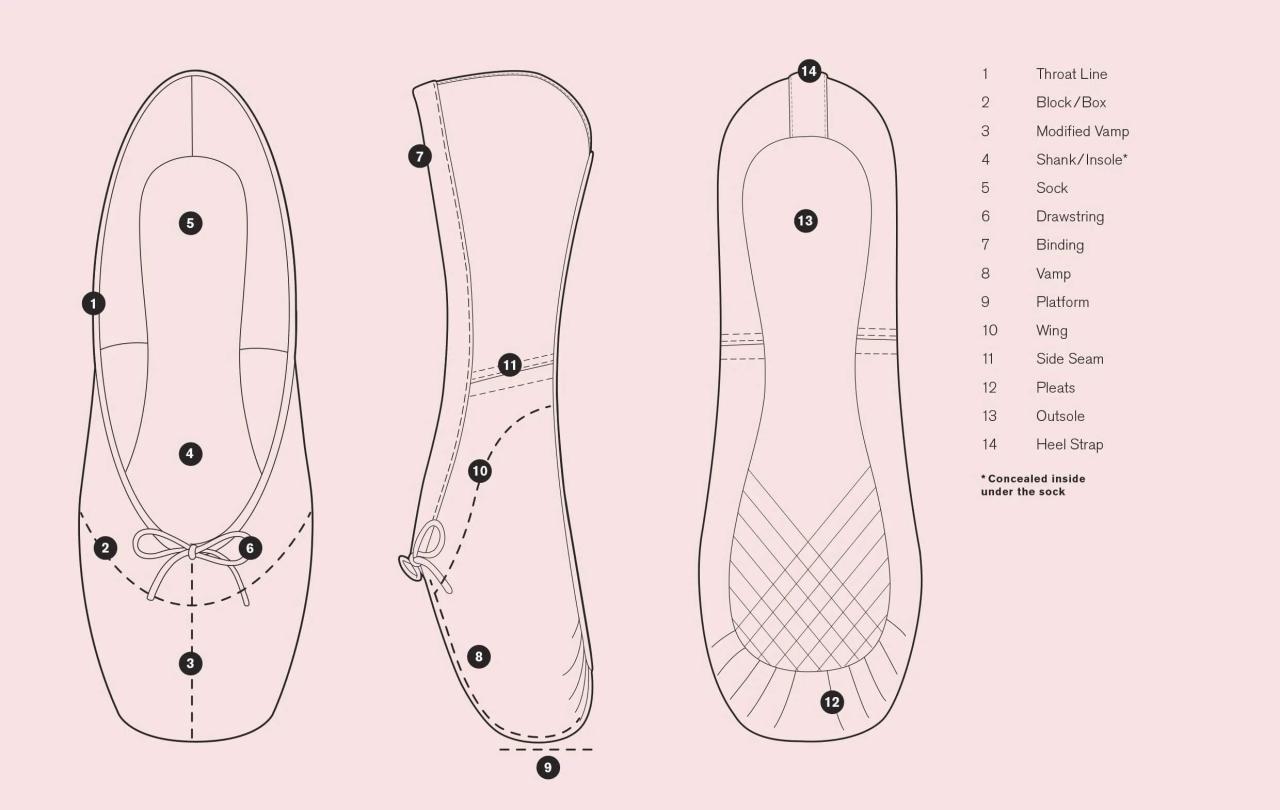
The construction of a pointe shoe involves a meticulous combination of materials and craftsmanship to provide the support and flexibility necessary for ballet dancers to perform on their toes.
The primary materials used in pointe shoe construction include:
- Satin or canvas:Forms the outer layer of the shoe, providing durability and aesthetics.
- Leather:Used for the sole, shank, and heel, offering strength and support.
- Paste:A blend of rosin, beeswax, and other materials applied to the sole for traction and longevity.
- Glue:Binds the various components together.
- Thread:Sews the shoe’s components together.
Visual Representation of a Pointe Shoe
The different parts of a pointe shoe include:
- Vamp:The upper part of the shoe that covers the foot.
- Box:The reinforced toe area that allows dancers to balance on their toes.
- Shank:The stiff midsole that supports the arch of the foot.
- Heel:The raised back of the shoe that provides stability.
Purpose and Function of Each Component
Each component of a pointe shoe plays a specific role in supporting the dancer:
- Vamp:Protects the foot and provides a snug fit.
- Box:Enables the dancer to balance on their toes by providing a stable platform.
- Shank:Supports the arch and helps prevent injuries.
- Heel:Provides stability and helps the dancer maintain balance.
Manufacturing Process of a Pointe Shoe
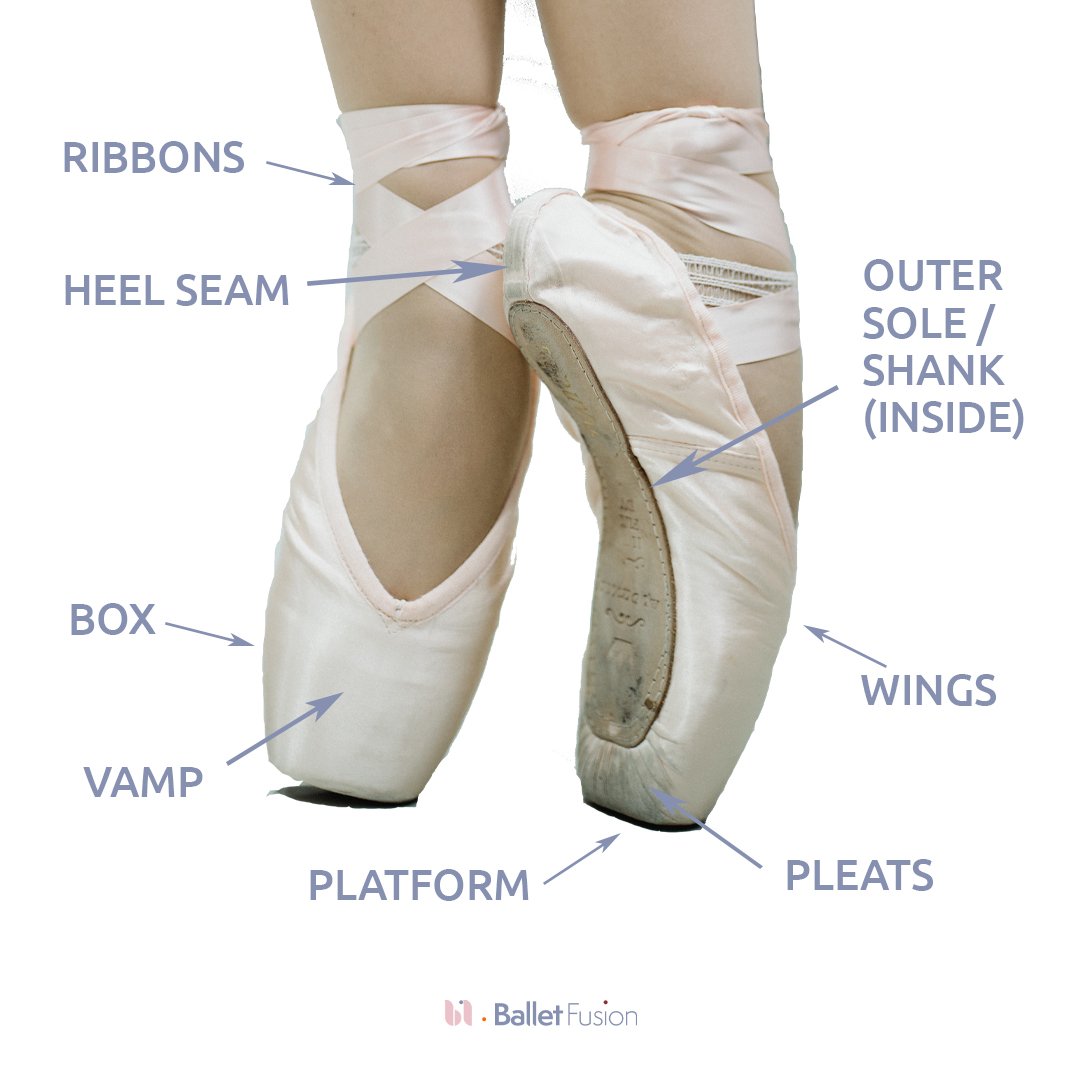
The creation of a pointe shoe is a meticulous and intricate process that demands both artistic flair and technical precision. Each shoe is meticulously crafted by skilled artisans, ensuring that dancers can perform at their peak while maintaining comfort and support.
Design and Cutting
The journey of a pointe shoe begins with the design, which is meticulously engineered to provide the dancer with optimal support and flexibility. The design is then transferred onto high-quality materials, such as satin, canvas, or leather, which are precisely cut to create the various components of the shoe.
Hand-Stitching
The intricate process of hand-stitching plays a crucial role in shaping and assembling the pointe shoe. Skilled artisans employ specialized needles and threads to meticulously stitch together the various layers of fabric, ensuring both durability and a precise fit.
Machine Sewing
In addition to hand-stitching, machine sewing is also employed to reinforce certain areas of the shoe and enhance its overall strength. Specialized machines are utilized to stitch seams, attach ribbons, and create the iconic pleats at the toe of the shoe.
To grasp the intricacies of a pointe shoe’s design, one must delve into its anatomical details. Intriguingly, this exploration aligns with the mathematical concept of “n cubed increased by 5” ( n cubed increased by 5 ), as the complexity of the shoe’s structure parallels the exponential growth inherent in this mathematical equation.
Returning to our study of the pointe shoe, we uncover the intricate interplay of its various components, from the supportive shank to the delicate ribbons.
Shaping and Molding
Once the shoe is assembled, it undergoes a shaping and molding process to achieve its distinctive form. This involves carefully manipulating the leather and fabric to create the desired arch and toe shape, ensuring a perfect fit for the dancer’s foot.
Quality Control
Rigorous quality control measures are implemented throughout the manufacturing process to guarantee the durability and performance of each pointe shoe. Each shoe is meticulously inspected to ensure that it meets the highest standards of craftsmanship and provides the dancer with the support and comfort they need to excel.
Pointe Shoe Customization and Fit
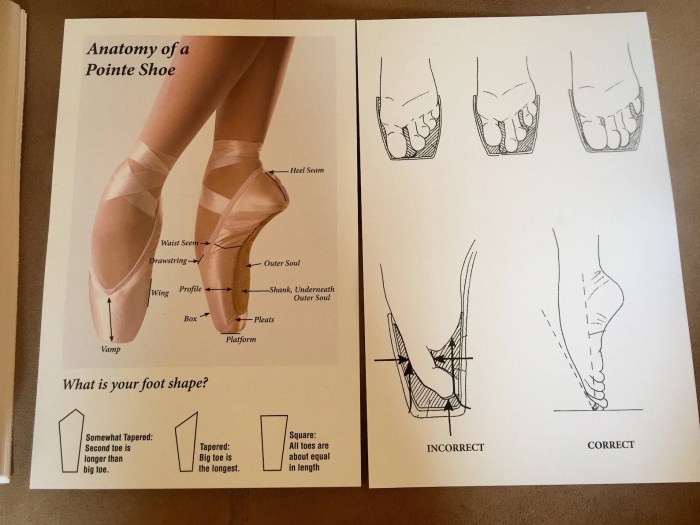
Achieving a perfect fit is crucial for pointe shoes to support and protect the dancer’s feet. This involves careful measurement, selection of the appropriate type of shoe, and professional fitting.
Dancer’s Foot Measurement
To determine the correct shoe size, the dancer’s feet should be measured while standing with weight evenly distributed. The length and width of each foot should be measured, and the measurements compared to the manufacturer’s sizing chart.
Choosing the Right Pointe Shoe
Pointe shoes come in various shapes and designs, each suited to different foot shapes and dance styles. Some key factors to consider include:
- Box Shape:The shape of the toe box, where the toes fit, can vary from round to tapered.
- Vamp Height:The height of the shoe’s upper, which can range from low to high.
- Shank Strength:The rigidity of the shoe’s sole, which determines its support and flexibility.
Importance of Proper Fitting
Properly fitted pointe shoes are essential for preventing injuries and ensuring comfort during dance. Ill-fitting shoes can cause pain, blisters, and even long-term foot problems.
A qualified professional should fit the dancer into pointe shoes, ensuring that the shoes fit snugly but not too tightly, and that there is no excessive pressure on any part of the foot.
Pointe Shoe Maintenance and Repair
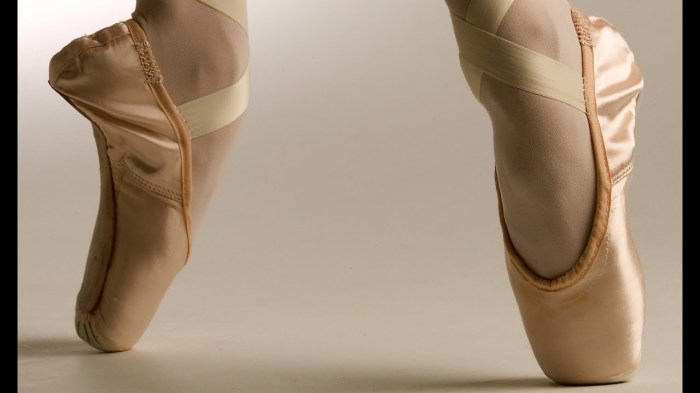
Maintaining and repairing pointe shoes is crucial for dancers to ensure optimal performance, prevent injuries, and extend the lifespan of their shoes.
Breaking In New Pointe Shoes
Breaking in new pointe shoes requires patience and a gradual approach to avoid discomfort or injuries:
- Wear the shoes for short periods initially, gradually increasing the duration.
- Perform barre exercises and simple dance steps to gently stretch the leather.
- Use a shoe stretcher or insert a tennis ball inside the toe box to widen it slightly.
Sewing and Gluing Pointe Shoes
Sewing and gluing pointe shoes can reinforce them and extend their lifespan:
- Sewing: Use a strong thread and needle to reinforce the seams, particularly around the shank and toe box.
- Gluing: Apply a thin layer of shoe glue to the inside of the toe box to prevent fraying and protect the fabric.
Signs of Wear and Tear
It’s essential to replace pointe shoes when they show signs of wear and tear to avoid injuries:
- Excessive wear on the toe box, causing holes or thinning.
- Weakening or breakage of the shank, leading to decreased support.
- Fraying or tearing of the satin upper, compromising the shoe’s integrity.
Pointe Shoe Aesthetics and Decoration: Diagram Of A Pointe Shoe
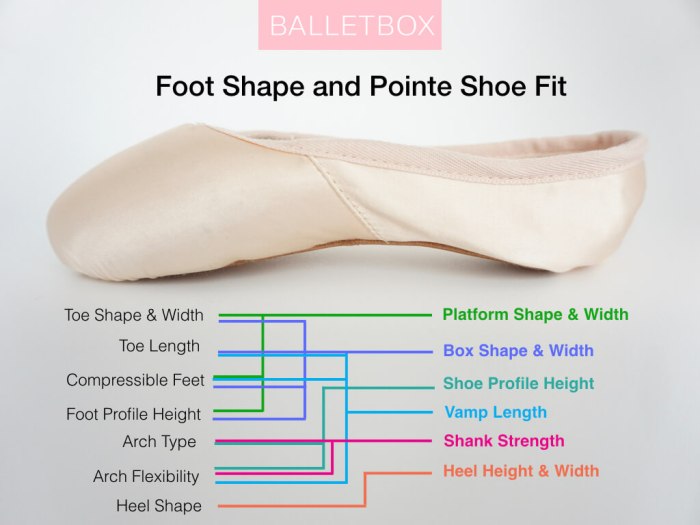
Pointe shoes are not just functional dancewear; they are also a form of artistic expression. Over the centuries, pointe shoes have evolved in terms of both design and decoration, reflecting the changing aesthetics and cultural significance of ballet. Today, pointe shoes come in a wide variety of colors, designs, and embellishments, allowing dancers to personalize their shoes and make a statement on stage.
Historical Significance
The aesthetics of pointe shoes have been influenced by various historical and cultural factors. In the early days of ballet, pointe shoes were primarily white, as this was the color of the satin used to make them. However, in the 19th century, dancers began to experiment with different colors, such as pink and black.
These colors were often used to create a specific effect on stage, such as making the dancer’s feet appear more delicate or dramatic.Today, pointe shoes are available in a wide range of colors, from traditional white and pink to more modern shades such as blue, green, and purple.
Some dancers even choose to decorate their shoes with embellishments such as ribbons, beads, and sequins. These embellishments can be used to create a unique and personal look that reflects the dancer’s individual style.
Personalization and Decoration
In addition to the traditional colors and embellishments, there are many other ways to personalize pointe shoes. Some dancers choose to dye their shoes a different color, while others add ribbons or other decorations to the straps or toe box.
There are also a number of companies that offer custom-made pointe shoes, which can be designed to fit the dancer’s specific needs and aesthetic preferences.No matter how they are decorated, pointe shoes are a beautiful and expressive form of dancewear.
They allow dancers to express their individuality and creativity while also enhancing their performance.
Pointe Shoe Safety and Injury Prevention
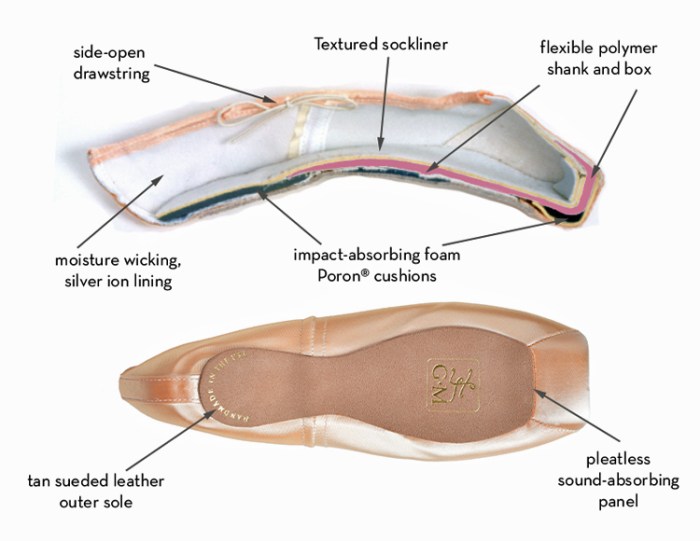
Wearing pointe shoes comes with potential risks and injuries due to the unnatural position and pressure on the feet. Dancers must undergo proper training and master the correct technique to minimize these risks. Additionally, dancers should prioritize foot care and follow guidelines to prevent common injuries associated with pointe work.
Injury Risks
Pointe shoes can cause various injuries, including:
- Blisters and corns: Friction and pressure from the shoes can lead to these painful skin conditions.
- Ingrown toenails: Tight-fitting shoes can cause toenails to grow inward, leading to pain and infection.
- Stress fractures: Repeated stress on the bones of the feet can cause tiny cracks or fractures.
- Bunions and hammertoes: Prolonged pressure on the toes can cause these bone deformities.
- Achilles tendinitis: Inflammation of the Achilles tendon, which connects the calf muscles to the heel bone.
Injury Prevention, Diagram of a pointe shoe
To prevent these injuries, dancers should:
- Start pointe work gradually, under the guidance of a qualified instructor.
- Wear properly fitted shoes that provide adequate support and cushioning.
- Use toe pads, gel inserts, and other protective gear to minimize friction and pressure.
- Stretch and strengthen the feet and ankles regularly.
- Listen to their bodies and rest when needed.
Query Resolution
What is the purpose of the box in a pointe shoe?
The box provides a rigid platform that supports the dancer’s weight and allows them to balance on the tips of their toes.
How often should pointe shoes be replaced?
The lifespan of pointe shoes varies depending on the frequency and intensity of use, but generally, they should be replaced every 12-16 hours of dancing.
What are the different types of pointe shoes available?
Pointe shoes come in various shapes, widths, and shank strengths to accommodate different foot shapes and dance styles.
How do I break in a new pair of pointe shoes?
Breaking in pointe shoes involves gradually increasing the amount of time spent wearing them while performing gentle exercises.
What are the potential risks of wearing pointe shoes?
Wearing pointe shoes can put stress on the feet and ankles, so proper training, technique, and foot care are crucial to minimize the risk of injuries.